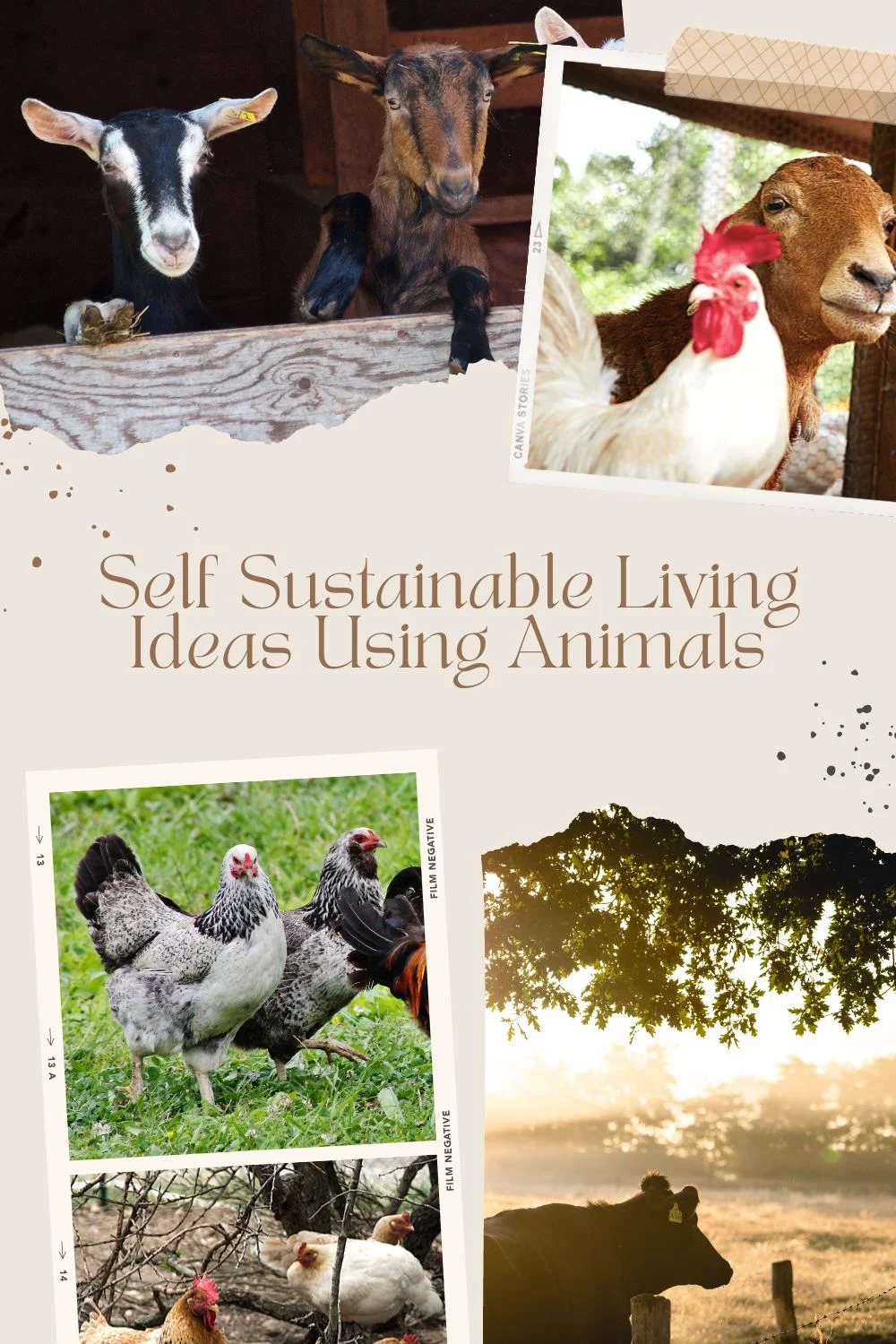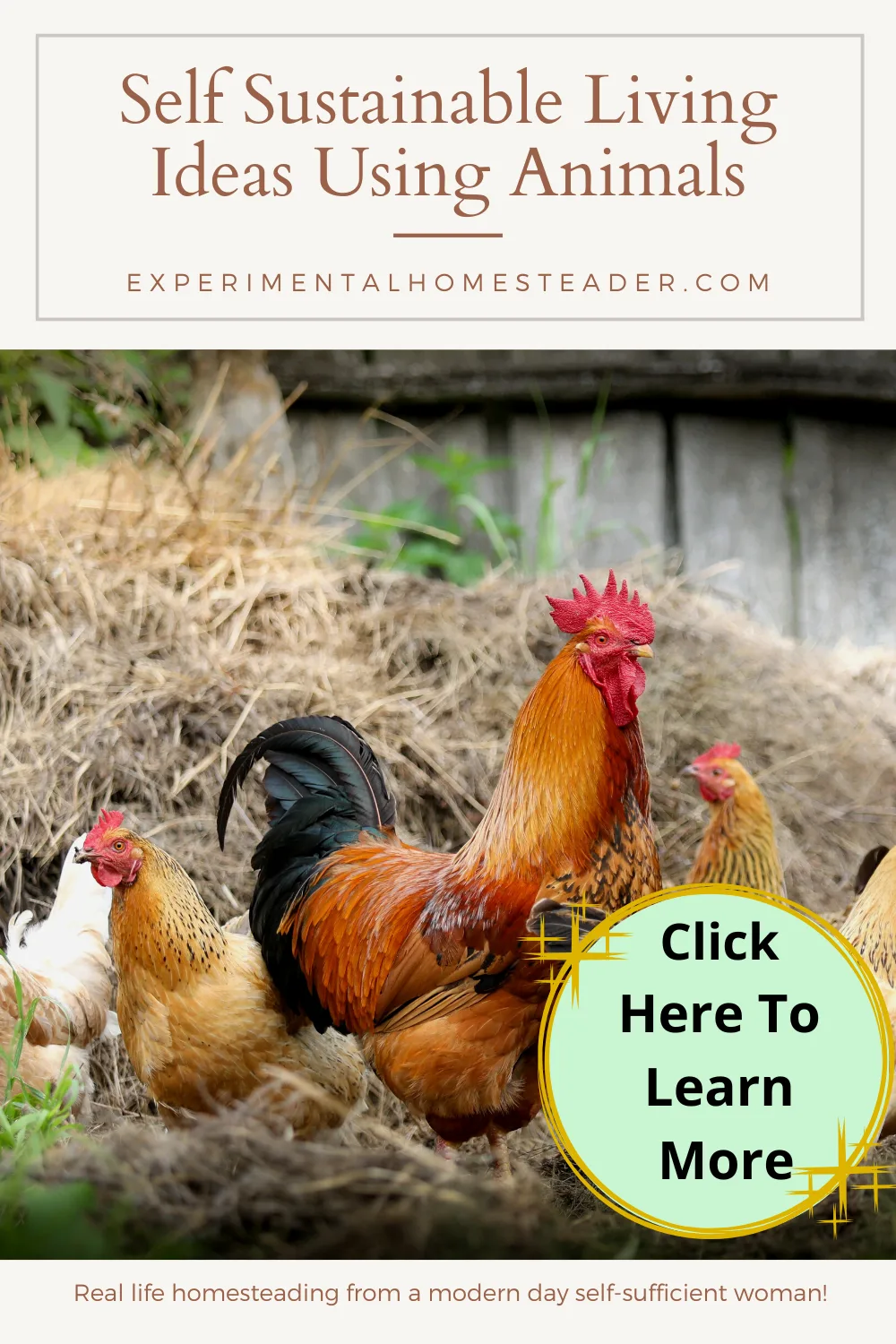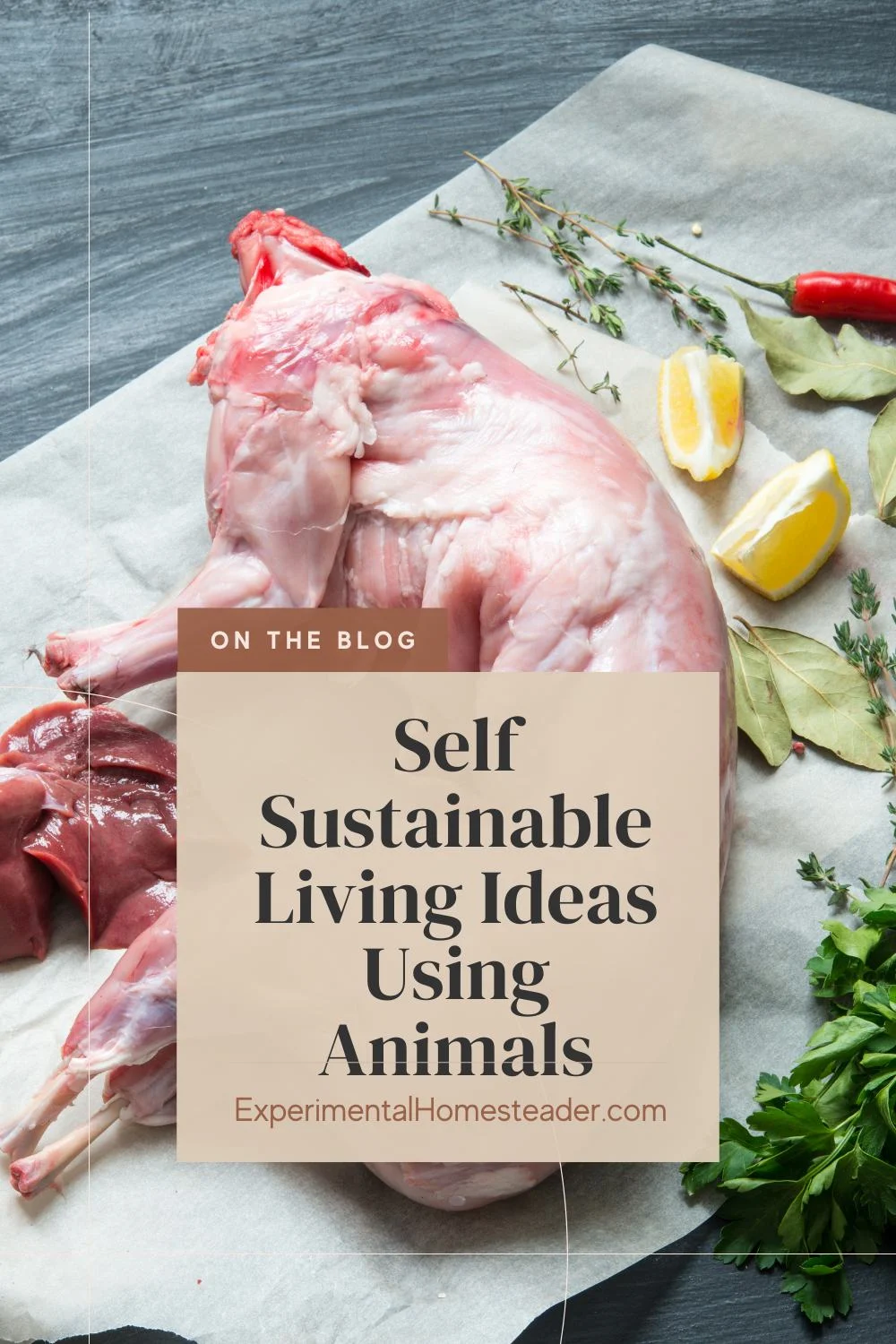There are a number of self sustainable living ideas that incorporate animals.
Some of these animals can be raised in town without any issues and others require land to raise them right.
The first step is to know what your local ordinances are, then choose the animals you wish to raise.
There are many ways you can use animals on your own property to help you become self-reliant and sustainable.
But before you begin, you need to know some of the most common animals used for sustainable living practices, and how you might use them to meet your needs.
Honor the Animal
Some animals are used for meat, while others are used for eggs, milk, or their pelts or skins.
It is important to note that using animals to help acheive your self sustainable living ideas requires you to be considerate of the animals needs and provide a healthy and happy environment for it.
When you choose to butcher animals, take the time to get proper training so that the killing of the animal does not cause fear or pain to them.
Sustainable living practices also make use of as much of the animal as possible so none of it goes to waste.
Honoring the animal's sacrifice means making use of the life the animal gave up to nourish you and your family.
Self Sustainable Living Ideas Using Chickens
If you are new to working with or raising animals, chickens or quail are a great way to begin learning.
Chickens and quail are relatively simple to take care of and require a small amount of space.
They can also provide regular eggs and even meat if you choose to butcher them and eat them.
You will need to make sure that you provide a coop for chickens and cages for quail so they can be safe from predators and roost at night.
Chickens need room to roam and can help cut down on bugs as they eat them along with the feed that you supply.
They are wonderful animals to use to clear weeds and weed seeds out of your garden before you plant it.
If you use them to keep garden rows cleared out, make sure they cannot get to your vegetables or they will eat them.
Chickens provide eggs, can be harvested for meat, and their feathers can be used for pillows, blankets or other crafts.
In the event you don't craft, the feathers make an excellent addition to your compost pile.
Older chickens that don't have tender meat can be used to make bone broth.
Getting Started Raising Chickens
It is best to choose an organic feed that is free from chemicals and additives.
I use Purina Organic Poultry Feeds and absolutely love the results.
Before you get started, you will want to do your homework to figure out how many chickens will fit into the chicken coop you choose.
That will depend on the size of the chicken coop and the breed of chickens.
You can buy chicks online and have them shipped to your home.
Or if you know someone who is already raising chickens, ask for some fresh, unrefrigerated eggs and try hatching them yourself.
You will need to be prepared to take care of the baby chicks for a few weeks after their arrival or after they hatch.
They need warm temperatures, clean water, and bedding that is changed at least once a day.
If it is warm enough outside and you have a chicken tractor, you can go ahead and put them into that instead of keeping them indoors.
As they grow, they will become easier to care for.
Many urban areas allow chickens, but make sure you check your local ordinances.
You may be allowed to have hens or even quail, but not roosters in the city limits.
As you care for your chickens, it is important to learn from experts such as agriculture extension agents, local farmers, or get help online.
Self Sustainable Living Ideas Using Rabbits
Rabbits are easy to care for and can provide meat for your family.
If you begin with two females and one male rabbit, you can produce more than 40 rabbits a year for meat.
Rabbits are best eaten when they are 8-12 weeks old.
The younger they are, the more tender they are.
When the rabbits reach about six weeks old, you can separate them from their parents.
Then you can wait until it is time to harvest the meat.
When the larger, adult rabbits reach two or three years of age, you can butcher them.
Older rabbits are better in stew because they aren't as tender.
Rabbits can also be used for their fur.
Once they're butchered and skinned for meat, you can tan the rabbit's hides and use them for warm clothing.
Rabbits are a relatively inexpensive investment if you want to begin working to raise and harvest your own meat.
It is best to take a class to learn how to butcher them properly before you decide to start raising them.
Getting Started Raising Rabbits
Rabbits require a hutch where they can live comfortably and have room to move around, or better yet, a dedicated stall that they cannot get out, with some type of outdoor access.
Some homesteaders build rabbit tractors to keep their meat rabbits in, but be aware that rabbits do dig and chew, meaning they will find a way out if the enclosure is not secure.
You will also need to feed them and provide them with high quality food and fresh vegetables.
Rabbits need a constant supply of alfalfa or timothy hay.
They also love fodder which is easy enough to sprout, just be sure to watch out for mold because you don't want to feed them moldy food.
Beyond The Pellet is an excellent resource for finding information on feeding rabbits.
You will want to research rabbit breeds so that you can choose the best breed for your area, and get the right breeds for the meat you plan to produce.
Self Sustainable Living Ideas Using Goats
Goats are fairly easy animals to take care of and they can produce quite a bit of food.
There are several kinds of goats - goats for meat and/or fiber as well as goats for milk.
Goat meat isn't a common meat eaten in the United States, but it is very common in other countries.
You want to choose a breed that is specifically designed for the purpose you have in mind.
Look for one that is purebred, however unless you intend to breed, registration papers are not a necessity.
Goats are also a great choice for helping to clear land because they love eating brush.
Getting Started With Goats
You can raise approximately eight goats on the same feed it would take to raise one cow.
Goats need little in the way of food if they are able to graze.
You may need to provide hay, oats or a grain, and a vitamin supplement.
I feed my goats an organic goat feed from New Country Organics.
Housing for goats is also pretty simple.
Goats need an area where they can be dry, where it is draft free and where they won't get too cold.
Pallets on the floor of the barn are a great way to let goats get up off a cold floor in winter.
Goats are very good at climbing, so you need a fence that has electric wire to keep them in or if you are using six foot tall chain link fence, like we are, use metal conduit at the top and bottom to keep them from climbing or pushing their way out.
If a goat can push on it and move it, or jump over it, they will get out.
Goats are typically very friendly animals to have on your property.
Recommended Goat Breeds
Some good goat breeds for meat include Boer, Kiko, Savanna and Texmaster.
Good goat breeds for milk include Nubian, LaMancha, Alpine, and Togenburgs.
Fiber goats include Cashmere, which is not a breed, but rather a goat that produces cashmere wool, and Angora, which is the goats that produce mohair.
You will want to learn more about specific breeds and what will work best in your area.
Dairy Goats
Goat milk can be used for drinking and for making cheese or other dairy products.
Many people who find cow's milk problematic find that goat's milk is a good substitute.
In order to produce milk, your goats will need to be bred once a year.
Your goat will need to feed her kids until they are weaned, but you can still milk her once a day.
The best method is to keep the kids separate from her at night and milk her once in the morning.
Then the rest of the day the kids can nurse when they choose.
Once the kids are weaned, you can milk twice a day.
If you continue to milk her, she can produce milk for approximately 10 months.
That is a good supply of milk for a family.
You can have more goats if you would like more milk for your use, to freeze goat milk for winter use, to make goat milk soap or lotion with or to sell, if it is legal to do so in your area.
Meat And Fiber Goats
When it comes to meat goats, the best time for butchering is between five and nine months of age.
You can learn to do this yourself or take the goat to a meat processor.
Goat meat freezes well, or you can preserve it by canning it if you prefer.
After butchering a goat, you can keep the hide and tan it for use.
If you choose to raise goats for fiber to spin into yarn, you will need some special equipment to harvest the fiber with.
Cashmere is harvested with a cashmere comb and mohair is shaved off the goat using electric animal shears.
Self Sustainable Living Ideas Using Pigs
Pigs are one of the more popular animals homesteaders raise for meat.
Pigs will need at least a tenth of an acre for pasture.
You can also grow them in an enclosure that is at least 100 square feet - such as a barn or an enclosed pen.
Pigs are often used in the spring to help till the land.
Then people follow behind the pigs with chickens so the chickens can eat the weeds and weed seeds.
Of course, this is not as fast as just using a tiller, but it does work and takes a lot less effort.
Taking Care Of Pigs
You will need food for your pig.
Unlike what you see in movies, it is best not to feed pigs just whatever is left over from your own meals.
They need a diet full of vitamins and minerals.
It is best to give them organic foods and allow them to graze on grass.
They also need plenty of access to clean water.
Also, you need to be aware that pigs do not sweat, so in hot weather a shower from a hose or a kiddy pool buried in the ground that they can cool off in is a great idea.
If you use a kiddy pool, it is best to clean it out and add fresh, cool water once a day.
Choosing A Piglet
You will want to choose a piglet that is a good breed for meat.
You can buy them at farms or from auctions, but if you choose to buy them from a livestock auction, know what to look for so you don't end up with a sick piglet.
Often farmers will sell the weaker pigs to homesteaders or others who have the time to give the piglet the extra care it needs to reach maturity.
I have bought these piglets before and with proper care, they thrive.
Some of the best breed choices include Berkshire, Yorkshire, and Hereford.
But there are many choices.
You will want to research what will live best in your area and grow to the preferred size.
When It's Time To Butcher Your Pigs
In general, pigs usually are ready for slaughter when they reach approximately 225 pounds, though this can vary.
You can learn to butcher them yourself or take them to a meat processor.
If you are using a meat processor, make plans ahead of time so you don't end up not being able to get an appointment to get your pig butchered.
Also find out if they want the pig delivered alive or not.
Each pig will give you somewhere between 150 and 300 pounds of meat.
Again, this is an average and will depend on your pigs size at butchering time.
Once a pig is processed into different cuts, you can freeze the meat or can the meat for long-term use.
Some people also choose to sell some of the meat from the pigs they raise as a way to make money and profit from pig production, just find out what the laws regarding this are in your area.
Self Sustainable Living Ideas Using Cows
Many people enjoy raising cows for either milk or meat.
Raising your own cows on a grass diet without antibiotics or added hormones makes the meat and milk much better for your body.
The best breeds for dairy cows tend to be Jersey, Guernsey, and Holstein.
For beef cows, look for Angus or Hereford cows.
There are other breeds that may be better for your needs, so do your homework before settling on one type.
Cows are good at clearing large areas of land as they eat stuff other animals might pass up.
This is why many homesteaders raise a variety of animals and rotate pastures.
Caring For Cows
Cows will need a source of grass and in winter months will need hay.
Each cow will need about a half a bale of hay per day.
Your cow will also need to be confined with a fence made from barbed wire or better yet, an electric fence to keep your cow from leaving home.
Each cow will need about two acres of pasture in order to get enough nutrition.
If you live in a drier area, your cow may need even more space.
Choosing Meat Or Dairy Cows
For milk cows, you will need to breed your cow in order for her to produce milk.
One cow can give you eight to ten gallons of milk each day.
This will allow you to have plenty of milk for drinking and making other dairy products or for selling, but again be sure this is legal to do in your area before you venture into doing it.
For meat cows, you can learn to do the butchering yourself.
However, most people will take a cow to be processed and divided into different cuts of meat as well as ground beef.
One cow is usually more than enough meat for an average family.
You may even consider selling half of the cow so that you can make back some of the money you have invested in raising your cow and processing it.
Be sure to find out what the laws regarding selling meat are in your area or ask a friend or family member to go in with you on splitting the costs of raising the cow as well as the processing costs of getting it butchered.
Self Sustainable Living Ideas Using Fish
When you think of farm animals, fish don't usually make the top of the list.
But fish is very good food that you can raise right on your property.
The best breeds of fish for farming include catfish, bass, bluegill, tilapia and carp.
In order to raise any of these fish, you will need a barrel that holds at least fifty gallons of water.
This will hold about 40 fish that you can harvest for food once they grow large enough.
You will want to research the specifics of putting together an aquarium or aquaponic system based on the breed you choose.
Caring For Farm Raised Fish
You will can choose to feed your fish commercial fish food or you can feed them worms.
For 40 fish, you will need at least 50-100 worms each day when they are young and even more as they get older.
You can either clean and prepare the fish all at once or stagger your use by taking a few adults out and replacing them with younger fish.
This gives you a regular supply of fish you can harvest.
If you do it all at once, you will need to freeze or can them.
It takes about two months for fish to grow into adulthood and be ready for eating.
You can also choose to start over every two months, with a new group of fish so that you have a continuous supply of fish to eat.
Whatever choice you make, consider things such as winter heat, where to keep the tank and if you are going with an aquaponic setup, what plants you intend to grow.
An aquaponic setup does cost slightly more than just an aquarium, but you get more food from it in the end if you count the vegetables you will harvest.
Also, if you choose to start over every couple months, use the aquarium water on any plants you are growing because it will be full of nutrients that the plants will love.
Start Small And Build From There
If you have never raised your own animals for food, it is a good idea to start small with chickens, rabbits, or even fish.
Don't try to do too much at once and become overwhelmed by the process.
Once you have mastered one group of animals - and the expenses plus work associated with them, you can add another group of animals.
It is also important to do a lot of research before deciding to raise animals.
Be sure to also research the various breeds to make sure they are hardy in your area and choose ones that are fairly easy to care for.
You need to do a lot of preparation and be prepared for feeding them twice a day, and even medical care if necessary, which can be pricy.
Researching Your Best Options
A great place to start is with your local agriculture extension office.
This office helps local people figure out what to grow.
You can even take educational classes to learn about animal management and harvesting.
This guide may have sparked your interest in a particular type of animal, but now you will need to get much more depth of information in order to carry out the process of growing and harvesting animals for food.
The Case For Raising Your Own Animals
Raising your own animals can help you save on the cost of food, but you do have to balance that with the cost of raising the animal.
It can also ensure that you have meat or milk that is free from chemicals, antibiotics, and hormones, which is why we raise our own animals.
You can also feel good that your animal has a good life and is treated with care and respect, unlike many animals raised on corporate farms.
Raising animals is a great way to develop a sustainable living homestead.
You can use them to help clear the land, do spring or fall garden cleanup and much more.
The amount of work they cut down on is wonderful, but you do have to balance that by the amount of time they take to care for.
Raising animals the right way does take a lot of work and it certainly isn't cheap, but many people feel that the time as well as the expense involved is well worth it for quality meat, fiber, or milk.
Self-Sufficient Living
Explore the ultimate guide to self-sufficient living with our curated list of related blog posts. From food preservation to DIY projects and homesteading inspiration, find everything you need to thrive on your self-sufficiency journey. Perfect for beginners and seasoned homesteaders alike!
The Essential Guide To A Completely Self Sufficient Homestead
Learn how to start living on a completely self sufficient homestead today with this essential guide plus sign up for our FREE eCourse!
How To Be Self-Sufficient In An Apartment
Learn how to be self-sufficient in an apartment. Even if you live in a big city you can learn skills you will use one day on your homestead.
Thriving Through Self-Sufficiency: A Journey to a Balanced Life
Learn how to thrive through self-sufficiency: slow down, live intentionally, and find balance for a healthier and more sustainable lifestyle.
Top 5 Tips for Balancing the Self-Sufficient Lifestyle: Stay Organized, Motivated, and Successful
Discover how to balance the self-sufficient lifestyle with actionable tips for organization, motivation, and sustainable success.
Step-by-Step Guide to Self-Sufficient Living: One Small Step at a Time
Start small with this step-by-step guide to self-sufficient living. Simple, achievable tips to ease into a sustainable lifestyle.
7 Ways To Start On The Path To A Self Sustaining Homestead
A self sustaining homestead is a lot of work but you do get a lot of satisfaction knowing you are living the self sufficient life you've dreamed of.
A Beginner's Guide To A Self Sufficient Homestead Plan
Making a self sufficient homestead plan is the first step to accomplishing your goal of living on a self sufficient homestead.
Seasonal Foraging Guide for Homesteaders: Year-Round Wild Edibles
Enhance your homesteading skills with our comprehensive seasonal foraging guide. Learn how to find and enjoy nature's delicious offerings.
Living The Homestead Lifestyle
Embarking on the homestead lifestyle is not easy. This is why I love Homegrown and Handmade by Deborah Niemann. The homestead tips are great!
Weapons To Include In Your Homesteading Self Sufficiency Survival Kit
Learn what weapons - both lethal and non-lethal - to include in your homesteading self sufficiency survival kit. Also learn why you need to include them.
Mockmill Flour Grinding Mill Makes It Easy To Grind Your Own Grain
The Mockmill flour grinding mill quickly and easily turns wheat berries into flour that is perfect for making freshly baked bread.
Homesteading Today In The USA
Although the Homestead Act of 1862 is no longer in effect, free land is still available for those wanting to try their hand at homesteading today.
How Much Land For A Homestead
When it comes down to the reality of how much land for a homestead you really need, it's much more than just a number. Learn what you need to consider.
What Homestead Living Is Really Like
Learn what homesteading living is really like. It's not always picturesque or romantic. In fact, sometimes it is difficult.
Food Security Preparedness - What To Do Before Disaster Strikes
Learn what food security preparedness skills you need to survive any natural or man-made disaster, and why you should grow your own food.
Learn To Be Self-Sufficient
Learn to be self-sufficient from Sheri Ann Richerson, a modern day self-sufficient woman with these eBooks and printables!
Preserving Herbs For Winter Use eCourse
Do you love fresh herbs but wonder if there is an easy way to preserve them for the winter?
Do you seek other ways to use herbs other than just as a seasoning on food?
There are so many ways to preserve herbs for winter use – from various methods of drying them to freezing them, but it doesn’t end there.
Some of the best ways to preserve herbs in right in the foods you would normally incorporate herbs into – pre-made seasonings, teas, butter or oil.
Then this is the course for you!
What You Will Learn In This Course:
Hang herbs to dry
Use a hanging herb dryer
Dry herbs on a window screen dryer
Dry herbs in a dehydrator
Dry herbs in an oven
Dry herbs in a microwave
Freeze herbs whole
Make herb ice cubes
Add fresh herbs to freezer meals
Add herbs to canned sauces
Preserve herbs in vinegar
Preserve herbs in oil
Preserve herbs in butter
Preserve herbs in salt or sugar
Make pre-made seasonings
Make herbal tea
Make herb jelly (plus tips on how to use these)





























